Easy Guitar Chord Forms for Beginner Guitarists
Table of Contents
Guitar Chords You Can Move on the Guitar Neck
A moveable guitar chord refers to different chord forms, or shapes, that can be moved to any fret while using the same group of strings, allowing you to play chords with any root note you need.
Power Chords
Power chords are probably the most beneficial guitar chords for most beginning guitarists to know. These chords can be played easily up and down the guitar neck, and are used in many songs. Power chords use the root note and the 5th note of a scale, and are also known as fifth chords. The root note's octave is used also, giving the power chord a bigger sound.
E5 Power Chord on Low E (6th) String
The E5 power chord can be played in the open position with the root note open on the low E string and 1 or 2 fingers to fret the A and D strings at the 2nd fret. This is the lowest sounding power chord while playing in standard tuning. This power chord form can be moved to any fret on the low E string using the same group of strings.
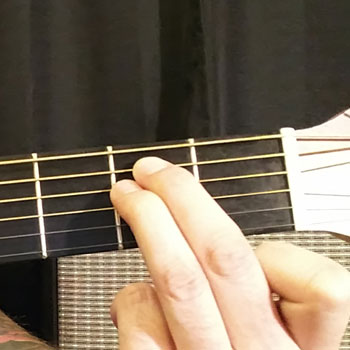
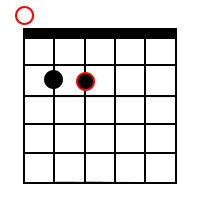
E5
e|---------|
B|---------|
G|---------|
D|----2----|
A|----2----|
E|----0----|
A5 Power Chord on A (5th) String
Moving down a string to the A string, the A5 power chord is played with the same chord form, or shape, as the E5 power chord. You can use 1 or 2 fingers to fret the D and G strings at the second fret. This power chord form can be moved to any fret on the A string using the same group of strings.
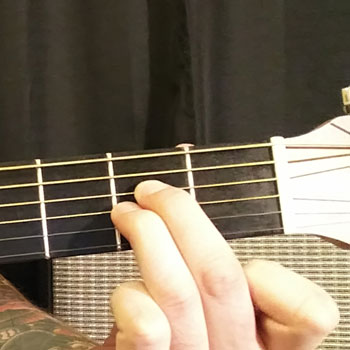
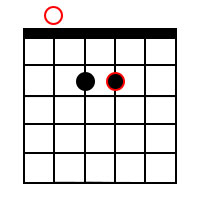
A5
e|---------|
B|---------|
G|----2----|
D|----2----|
A|----0----|
E|---------|
D5 Power Chord on D (4th) String
Power chords with the root note on the D string take a different form than the power chords on the 6th and 5th strings. The octave (repeated root note) will be played one fret higher than in the previous power chord forms.
The D5 power chord in the open position is played with the D string open and uses one finger to fret the G string at the 2nd fret, and another finger to fret the B string at the 3rd fret (not the 2nd). You can move this power chord form to any fret on the D string using the same group of strings.
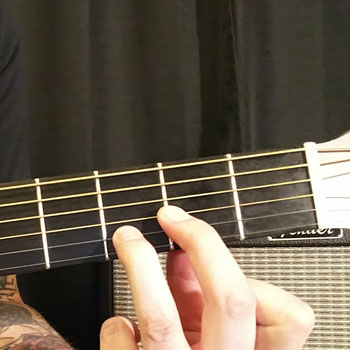
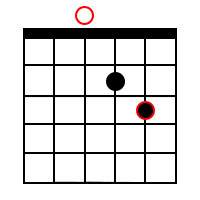
D5
e|---------|
B|----3----|
G|----2----|
D|----0----|
A|---------|
E|---------|
G5 Power Chord on G (4th) String
Power chords on the G (3rd) string also have a different form. The root note has 2 frets between the 5th and octave notes. The G5 power chord is played with the G (3rd) string open and the 5th and octave fretted at the 3rd frets of the B (2nd) and high E (1st) strings.
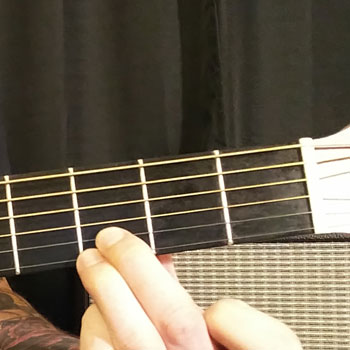
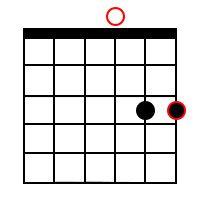
G5
e|----3----|
B|----3----|
G|----0----|
D|---------|
A|---------|
E|---------|
Basic Chord Progression using Power Chords in Standard Tuning
A5 D5 E5
e|--------------------------------------|
B|--------------3--3--3--3--------------|
G|--2--2--2--2--2--2--2--2--------------|
D|--2--2--2--2--0--0--0--0--2--2--2--2--|
A|--0--0--0--0--------------2--2--2--2--|
E|--------------------------0--0--0--0--|
Using a Drop Tuning
One way to jump right in to playing power chords is tuning your guitar to a drop tuning such as drop D. Drop D tuning is one string alteration from standard tuning, dropping the low E (6th) string down to D. Barring (holding down the strings with one finger, like a bar) the 6th, 5th and 4th string allows you to easily play power chords with more speed and ease.
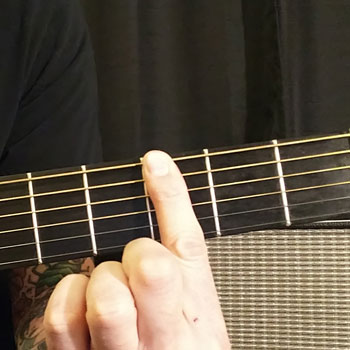
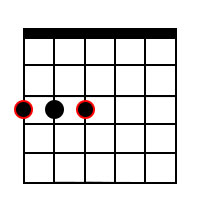
Using the Drop D Power Chord Form in a Chord Progression
E5 A5 B5
e|--------------------------------------|
B|--------------------------------------|
G|--------------------------------------|
D|--2--2--2--2--7--7--7--7--9--9--9--9--|
A|--2--2--2--2--7--7--7--7--9--9--9--9--|
D|--2--2--2--2--7--7--7--7--9--9--9--9--|
Easy Open Chords for Beginners
Open chords are guitar chords with at least one unfretted string played within the chord. These chords are played in the open position, located near the nut of the guitar.
The Open E Minor Dominant 7 Chord
The open E minor dominant 7 (Em7 or Em dom7) chord can be played using just 1 finger on the 2nd fret of the A (5th) string, and playing the rest of the strings open.
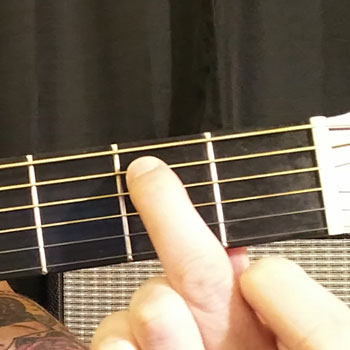
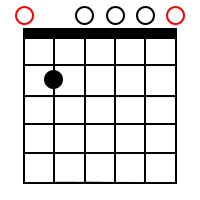
Em7
e|----0----|
B|----0----|
G|----0----|
D|----0----|
A|----2----|
E|----0----|
The Open E Dominant 7 Chord
The open E dominant 7 (E7 or E dom7) chord can be played using 2 fingers, and playing the rest of the strings open.
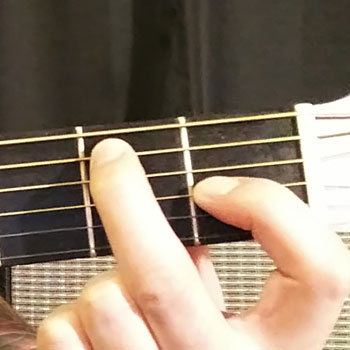
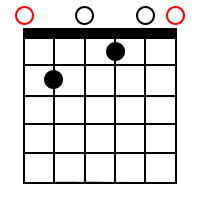
E7
e|----0----|
B|----0----|
G|----1----|
D|----0----|
A|----2----|
E|----0----|
The Open E minor Chord
The open E minor (Em) chord can be played using 2 fingers on the 2nd fret of the A (5th) and D (4th) strings, and playing the rest of the strings open.
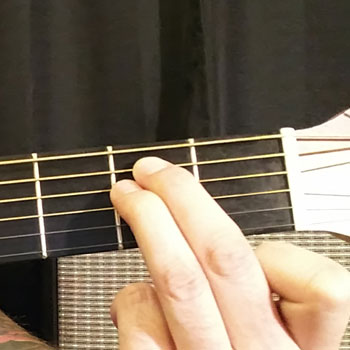
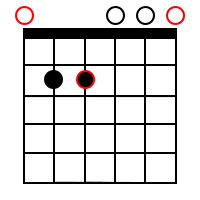
Em
e|----0----|
B|----0----|
G|----0----|
D|----2----|
A|----2----|
E|----0----|
The Open A Dominant 7 Chord
The open A dominant 7 (A7 or A dom7) chord uses 2 fingers on the 2nd fret of the D (4th) and B (2nd) strings. Except for the low E (6th) string, the other strings are played open.
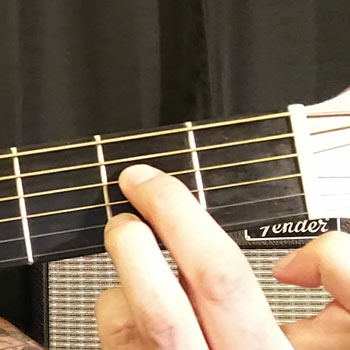
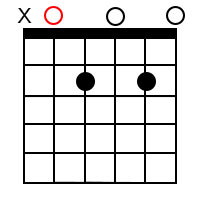
A7
e|----0----|
B|----2----|
G|----0----|
D|----2----|
A|----0----|
E|---------|
The Open A Minor Dominant 7 Chord
The open A minor dominant 7 (Am7 or Am dom7) chord uses 2 fingers; one on the 2nd fret of the D (4th) and the other on the 1st fret of the B (2nd) string. Except for the low E (6th) string, the other strings are played open.
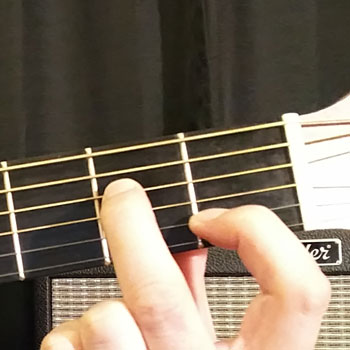
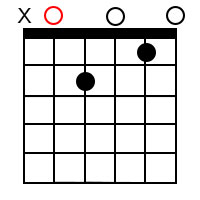
Am7
e|----0----|
B|----1----|
G|----0----|
D|----2----|
A|----0----|
E|---------|
The Open A major Chord
The open A major chord uses 3 fingers on the 2nd fret of the D (4th), G (3rd), and B (2nd) strings. This chord can also be played by barring one finger on the same strings, but can often mute the open high E (1st) string.
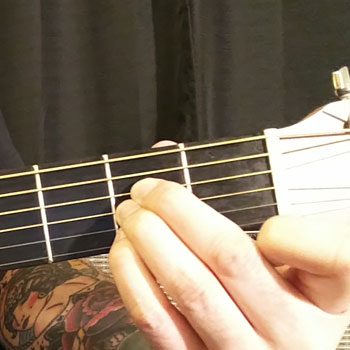
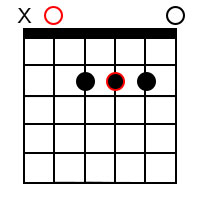
A
e|----0----|
B|----2----|
G|----2----|
D|----2----|
A|----0----|
E|---------|
What to Expect with Learning to Play Guitar Chords as a Beginner
Learning new chords, and learning to play the guitar in general, can be a difficult process. Don't get discouraged if you can't play certain chords or scales right away. Learning to play the guitar will get easier as you learn and practice.
You might think your hands or fingers aren't the right size to play guitar.
This is a common beginner guitarist complaint or thought. In most cases it's not the size of your hand or fingers.
Beginners who think their fingers are too small typically are gripping the guitar neck in a way that limits the movement of the rest of the hand and fingers. How you hold your fret hand will likely differ from how you see others playing their guitar. Keep your thumb in the middle of the back of the guitar neck. Everyone's hands and fingers have different sizes and ranges of movement. Dexterity will develop in different ways for each beginner.
Your Fingers will Hurt in the Beginning.
As you play the guitar, your fingers will go through a few changes every guitarist experiences. The strings on the guitar will start to create calluses on the tips of your fingers, especially with an acoustic guitar.
When you're first starting out, your fingers and hand might not have enough strength to play certain chords right away. This is normal and will start getting easier the more you practice.
☠ The F Chord ☠
The F chord is one of the most difficult chords to play as a beginner, and can take more time to learn to play. The F chord is a barre chord located on the first fret of the guitar. The string tension is the highest at this fret, and requires more finger strength. Barre chords in general are harder to play at first, but are easier to play on locations of the guitar neck where the string tension isn't as high.
Chord Theory for Beginners
What is a Chord?
A chord is a term in music for a group of notes played together at the same time. The notes of a chord are spaced out at different intervals and determine what kind of chord it is. A basic chord, or triad, typically is made up of a root note, the 3rd, and the 5th. Other notes of the scale are used in different chord voicings.
- Chord names are based on the root note, and other notes that might be used.
- Major chords are played with the 3rd note of the root note's scale in its normal position ("major 3rd").
- Minor chords use the flat(♭) 3rd ("minor 3rd or 3♭") of the root note's scale.
- In many guitar chords one or more notes are repeated within the same chord form